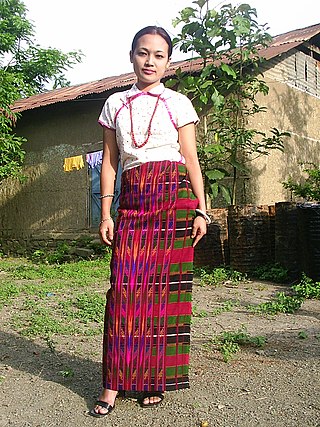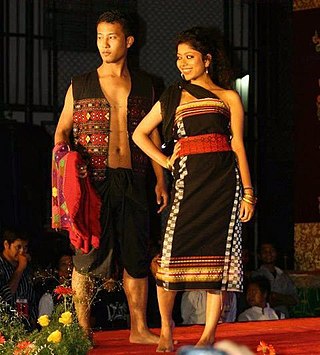Related Research Articles
Hmar is an Kuki ethnic group living in Northeast Indian state of Manipur, Mizoram, Assam and western Myanmar (Burma) and eastern Bangladesh. They use Meitei language as their second language (L2) in Manipur. They speak Mizo language as their L1 in Mizoram.
Gangte is an ethnic group mainly living in the Indian state of Manipur. They belong to the Zo people and are parts of the Kuki or under Mizo tribe and are recognised a tribe of Manipur, India. They are also indigenous inhabitants of Mizoram, Assam and Myanmar, and a recognised tribe under the Indian Constitution. With a population of approximately 40,000 worldwide, they primarily live in Manipur's southern Churachandpur district and neighbouring states of Meghalaya, Mizoram and Assam. (L2) according to the Ethnologue.
The Koireng people are one of the indigenous peoples inhabiting Manipur in North-East India. They have a shared common ancestry, history, cultural traits, folklore and dialects with their kindred people like Aimol and Kom. They use Meitei language as their second language (L2) according to the Ethnologue.

The Mizo people are a Tibeto-Burmese ethnic group native to the Indian state of Mizoram and neighbouring regions of Northeast India. They are related to the Zomi people and Chin people. The term Mizo covers several related ethnic groups or clans inside the Mizo group. The term Kuki, derived from Bengali, was used as a general classification in government records for the Zo ethnic groups who resided in the Lushai hills region. However, with the establishment of the state of Mizoram, the term Mizo became more widely recognized and used.

Dima Hasao district, is an administrative district in the state of Assam, India. As of 2011, it is the least populous district of Assam.

The Kuki people are an ethnic group in the Northeastern Indian states of Manipur, Nagaland, Assam, Meghalaya, Tripura and Mizoram, as well as neighbouring countries of Bangladesh and Myanmar. The Kuki constitute one of several hill tribes within India, Bangladesh, and Myanmar. In Northeast India, they are present in all states except Arunachal Pradesh.

The Zou people are an indigenous community living along the frontier of India and Burma, they are a sub-group of the Kuki people. In India, they live with and are similar in language and habits to the Thadou people and Paite and the Simte peoples. In Burma, the Zou are counted among the Chin people.They are a hill people, "Zou" may plainly means "Hills" denoting the Zous are "people of the hills" or "of the hills", and "Zou" has also a different meaning in Zou language that is "complete" or another word for it is "finish". But, the Zou people believed that they incepted the name 'Zou' from their forefather 'Zou' or 'Zo', believed to be the progenitor of the broad Chin-Kuki-Mizo people.

Zo is a Northern Kuki-Chin-Mizo language originating in western Burma and spoken also in Mizoram and Manipur in northeastern India.
Thadou or Thado Chin is a Sino-Tibetan language of the Northern Kuki-Chin-Mizo sub-branch. It is spoken by the Thadou people in Northeast India. The speakers of this language use Meitei language as their second language (L2) according to the Ethnologue.
The Zo people are an ethnic group which inhabit areas of India, Myanmar and the Chittagong hill tracts of Bangladesh. The word Zohnatlâk/Zo is used to describe an ethnic group, which is also known as the Chin, the Mizo, the Kuki, or a number of other names based on geographic distribution, that speaks the Kuki-Chin languages. They are from same origin which is known as Sinlung. They spread throughout the northeastern states of India, northwestern Myanmar and the Chittagong Hill Tracts of Bangladesh. In northeastern India, they are present in Tripura, Nagaland, Mizoram, Manipur, Meghalaya and Assam.

The Biates are an ethnic hill tribe of Assam, Meghalaya, Mizoram, Tripura and Manipur. Their language belongs to the Tibeto-Burman family. Spread over many parts of North-East India, they have a unique identity with a rich and distinctive history, culture, dialect and religious heritages. They are one of the oldest hill tribes of North East India especially among the Chin-Kuki-Mizo people. The term Biate comes from the word Bia-te. The word ‘Bia’ or ‘Biak’ means ‘speak’ or ‘worship’. ‘Te’ is a suffix denoting plurality. Hence, the two words combine to form the word Biate, which means worshipper.
Sakachep also known as Khelma, is a Central Kuki-Chin-Mizo language of Northeast India. Dialects are Khelma, Thangachep, and Sakachep (Ethnologue). VanBik (2009) classifies Sakachep as closely related to Hmar.
Vaiphei is a Sino-Tibetan language belonging to the Kuki-Chin linguistic subbranch of the Tibeto-Burman group of languages. It is spoken mainly in the Indian state of Manipur and minutely in Mizoram, Assam, Meghalaya, and Tripura. The dialect spoken in Manipur exhibits a least partial mutual intelligibility with the other Mizo/Kukish dialects of the area including Thadou, Hmar, Paite, Simte, Kom and Gangte languages.

Gangte is a Sino-Tibetan language of Kuki-Chin linguistic sub branch of Northeastern India. Its speakers primarily live in Manipur and the adjacent areas of Meghalaya and Assam. The language appears to be homogeneous with no known dialectal variation and exhibits at least partial mutual intelligibility with the other Chin-Kuki-Mizo dialects of the area including Thadou, Hmar, Vaiphei, Simte, Kom and Paite languages. The speakers of this language use Meitei language as their second language (L2) according to the Ethnologue.

Thadou people and are an indigenous tribe of Kuki people inhabiting Northeast India, Burma, Bangladesh, Israel.
Simte is a Kuki-Chin language of India. It is spoken primarily by the Simte in Northeastern India, who are concentrated in Manipur and adjacent areas of Mizoram and Assam. The dialect spoken in Manipur exhibits partial mutual intelligibility with the other Kuki-Chin dialects of the area including Thadou, Hmar, Vaiphei, Paite, Kom and Gangte. It is written in Latin script.
Ranglong is an ethic people belonging to the old kuki chin, majority of Ranglong's live in the northeastern part of India, mainly in the border area's of Tripura, Assam and Mizoram. The Ranglong people live in a small and densely-packed area over three federal Indian states,(tripura, Assam and Mizoram)

Aimol, also known as Aimual, is a Sino-Tibetan language spoken by the Aimol people of Manipur, India. It is considered endangered and has less than 9,000 speakers worldwide as per 2011 census. The speakers of this language use Meitei language as their second language (L2) according to the Ethnologue.

The Faihriem, or Saihriem, are one of the clans of Hmar tribe located in the Indian states of Assam, Manipur and Mizoram who speak the Saihriem dialect.
The Hmar languages or Hmaric languages are a subbranch of the Kukish branch of the Sino-Tibetan language family which comprises Hmar proper (Khawsak), Biate, Hrangkhol, Sakachep, Zote, Darlong, Thiek, Saihriem (Faihriem) and others. The Hmar languages are often treated as dialects of a single language, since differences between them are reportedly minor. The speakers of the language are also known as Hmar.
References
- 1999, Robin D. Tribhuwan, Preeti R. Tribhuwan, Tribal dances of India ( Encyclopaedic profile of Indian tribes, volume 1), page 117: […] 21 clans. They are Biete, Changsan, Chawrai, Darngawn, Faihriem, […] and Zote. The past tradition suggests that each clan had a dialect of its own but nowadays a common dialect used by the Hmar people was developed by Christian missionaries
- 1902, B.C. Allen, B.A., I.C.S., Census of India, 1901. Volume IV. Assam. Part I. Report. Print. Chapter VIII, page 90.
